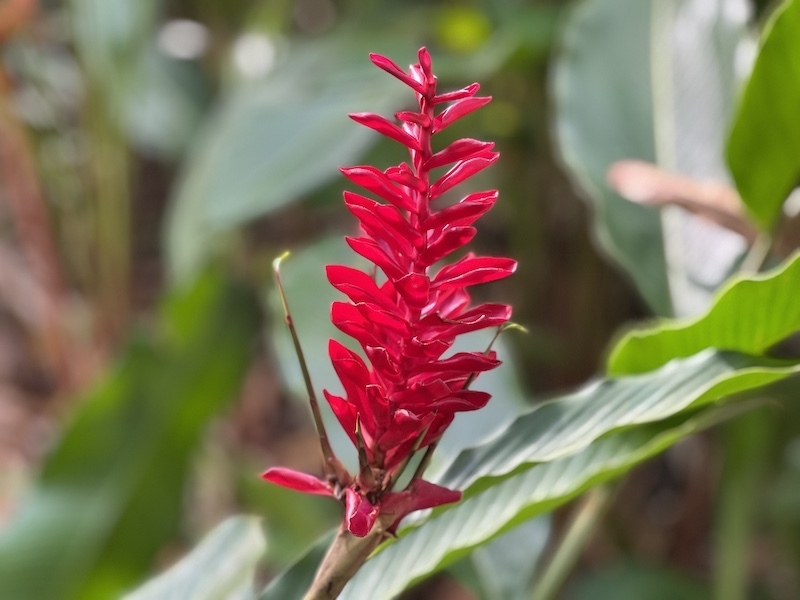Find lounging on a beach boring? Try rainforest rides, cocoa agritourism and volcanic mud baths…
“Ferns are ancient, they were around when dinosaurs roamed the earth,” said our guide Nally, pointing to a clump of gigantic West Indian tree ferns towering ahead of us. Deep in St Lucia’s rainforest, ascending towards a distant canopy and surrounded by dense vegetation, it did feel very Jurassic Park. Lurking through the trees was La Sorcière (Sorceress’ Mountain), which legend says can “bewitch” hikers navigating her slopes, while strangler figs suffocated their arboreal victims in thick lattice prisons.
Talking of strangling, did you know there are boa constrictors in St Lucia? “We actually have a few different snakes here, including a blind native threadsnake. But fortunately we don’t encounter them much!” Probably in her early twenties, with a braided ponytail and mischievous smile, Nally was the nature guide assigned to our Rainforest Adventures aerial tram. And boy was she a font of information.

As we slowly ascended through the forest understory, enjoying the warm breeze and meditative soundtrack - rustling leaves, rushing water, the occasional beeping of a red-snouted tree frog - we were given an engaging commentary on what we were passing… Monkey paws vines, swirling up trunks like intricate tattoos. Bromeliads, their leaves curled into rosettes to catch precious water. Cinchona trees, whose quinine has long been used to fight malaria. Vanilla vines, notoriously difficult to cultivate. Gommier trees, whose resin was once collected by the Taíno, indigenous Caribbean people, to make torches. Magnolia trees, apparently a favourite of the elusive St Lucia parrot (main image), and plenty besides.
We spotted the odd critter too: from the delightfully named pearly-eyed thrasher, which looks bit like a thrush, to purple-throated carib hummingbirds fluttering among the hibiscus flowers. Not all the flora and fauna are native, but they thrive in this balmy and biodiverse environment.

Surprisingly, we learned the forest reserve has also been home to a very different kind of animal - humans. “A group of Rastafarians used to live there, they called it Zimbabwe.” Nally gestured to an area on our right, once peppered by huts thatched with banana leaves, vegetable plots and goats. Now there was no sign of this community, though some of the cannabis they planted remains. Nally explained they were forced to leave as it was believed they were contaminating the water (we were in the Castries Waterworks Forest Reserve, first established to protect the capital’s water supplies).
Finally we reached the gondola’s highest point, some 1500 ft above sea level, and turned to begin the descent. Here above the canopy, the vista was impressive, as tree-clad slopes marched towards a seductive peep of baby-blue Caribbean Sea. “This is the second-best view you’ll see today, the first was me,” Nally quipped. The Rainforest Adventures guides are known for their gentle sense of humour; “50 shades of green” was another joke I heard, describing the varied verdant hues of our surroundings.
Amid gnarly buttress roots and striking red-yellow heliconias, often compared with lobster claws or toucan beaks, we followed our tram ride with a short walk in the rainforest gardens. We learned how melon-like calabash fruits are used to make containers, felt the raspy leaves of the sandpaper vine and tasted the sour-apple kick of wax begonia flowers. Rounding off the experience with a refreshing tamarind juice in the open-air bar, under the beady eye of a Lesser Antillean bullfinch, I felt the deep contentment that only nature can bring.

Like many of its Caribbean neighbours, St Lucia is famed for its paradisiacal beaches and plush resorts. But as “eco-tourism” becomes an ever bigger buzzword, and tourists look for more than a fly-and-flop holiday, nature-based activities continue to grow. Joining the likes of Kayak on the Bay and St Lucia Eco Adventures, recent initiatives include St Lucia Bamboo Rafting plus The 758 Adventurers and Three Peak Challenge (which comprises Mount Gimie and the two UNESCO-listed Pitons). And they’re just for starters.
Of course you could do something less strenuous, like my aerial tram ride, or create your adventure instead. As Neil Sowerby wrote in his 2020 article, earthy highlights abound: from the mud baths of Sulphur Springs to an array of cocoa-based experiences in the island’s lush hinterland. The point is that there are myriad ways to enjoy St Lucia’s natural environment beyond lazing on a beach.

As for further attractions besides sea and sand? Think Creole cuisine, artisanal shopping and a lively event calendar to name but three; 2024 is especially exciting as the annual Jazz & Arts Festival, one of the country’s biggest celebrations alongside its July carnival, celebrates 30 years.
So leave the sun loungers awhile and go exploring. St Lucia’s other temptations are calling...
Fact file
British Airways has daily flights from London Gatwick to St Lucia’s Hewanorra International Airport all year. TUI flies once a week from Gatwick, while Virgin Atlantic operates a seasonal service (from November to May) three times a week from Heathrow.
For more information on St Lucia, see stlucia.org.













